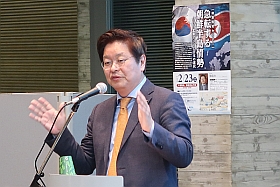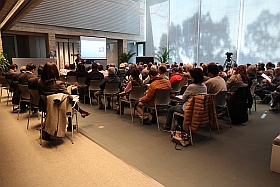After the 2nd US-DPRK Summit in Hanoi, Vietnam: Sustain the Inter-Korean Momentum
Mark Byung-Moon Suh, Council Member, Pugwash Conferences on Science and World Affairs, Member of the German Council on Foreign Relations and
Elisabeth Imi Suh, Research Assistant, German Institute for International and Security Affairs
PSNA Working Paper Series (PSNA-WP-4)1
March 6, 2019
The much expected and awaited second meeting between Donald Trump and Kim Jong Un abruptly ended without any agreement and will go down in history as the 2019 no deal-summit. Surely, the lack of an agreement is disappointing; it does not equate, however, to the end of diplomacy with North Korea. What went wrong and what needs to be done to keep the momentum of peace process in Korea?
Two Track Diplomacy vis-à-vis North Korea
After the tension-loaded year of 2017, diplomacy on the Korean peninsula quick-started after Kim Jong Un’s New Year’s speech at the beginning of 2018. The progressive administration in Seoul had iterated offers for inter-Korean dialogue since the inauguration of Moon Jae-in in May 2017. Moon was very keen on bringing North Korea and the US to negotiating tables, and careful to set the right tone as he did in his Berlin speech July 2017. His genuine interest in dialogue with the North – important not for the sake of accelerated reunification, but in the name of joint Korean ownership of peace and stability on the peninsula – has translated into the re-establishment of crisis communication channels, the institutionalization of working-level dialogue through e.g. the liaison office in Kaesong as well as leader-to-leader meetings that resulted in the Panmunjom Declaration of April 2018, the Pyongyang Declaration and Military Agreement of September 2018. Seoul’s continuous endeavor to constructively engage Pyongyang and to find mutually acceptable steps towards political reconciliation, military confidence-building and economic cooperation has spilled into a relatively stable track of inter-Korean dialogue(s).
US-North Korean diplomacy, however, stands in stark contrast to this: Donald Trump’s initial willingness to meet directly with Kim quickly fell into oblivion with his 2017 maximum pressure campaign and “fire and fury” rhetoric. While first inter-Korean talks and Pyongyang’s high-level attendance of the Pyongchang Winter Olympics in February 2018 were met with US discontent, nevertheless, Trump gratefully accepted Kim Jong Un’s invitation that was extended by Seoul’s special envoys in March 2018. Diplomacy between Washington and Pyongyang since then, however, appears rather as “off-again on-again” momentum of dialogue and summitry: First high-level talks between the Trump administration and Kim regime were followed by the cancellation and then resumption of preparations for their first summit meeting, finally resulting in the Singapore Summit and its consequent declaration of intentions in June 2018. Besides frictions in July, August and November, high-level meetings between Washington and Pyongyang took place in July and October. High-level meetings in the run-up to the Hanoi Summit, and especially working-level talks in January and February, were cause of high hopes for the second encounter of Donald Trump and Kim Jong Un. The ups and downs in US-North Korean interactions as well as the no deal-summit reveal the shortcomings of the US administration’s approach to Pyongyang.
The Singapore Summit in June 2018: Start of a new relationship?
The first-ever leadership interaction between the US and North Korea supposedly marked the beginning of a fundamentally new bilateral relationship and the start of an innovative top-down approach to diplomacy. The Trump administration explicitly distances itself from previous administrations’ North Korea policies – which is correct in terms of its willingness to directly and personally engage Pyongyang’s leader(ship) without explicit preconditions. In terms of content, however, US positions remain the same and rather increasingly emphasize the threats posed to its national security by North Korea’s ICBM and uranium enrichment capabilities.
On a rhetorical level, Donald Trump has played with ideas of withdrawing all US troops from South Korea, of opening liaison offices and declaring the end of the Korean War. The no deal-summit of Hanoi, however, bluntly revealed the actual stakes being discussed and the narrow room for maneuver: While Pyongyang insists on the partial lifting of sanctions and suggests the focus on confidence- and relationship-building measures, Washington shows no flexibility nor creativity in allowing for compromise in terms of North Korea’s nuclear weapons and ballistic missile programs. Although details of the failure to reach agreement in Hanoi remain to be seen, the Trump administration has passed up the opportunity to put Pyongyang’s nuclear testing and missile moratorium into writing, to sign a narrow deal consisting primarily of allowing inspectors into Yongbyon and to declare the end of the Korean War. These three milestones would have put negotiations on track towards building actual confidence, and towards achieving peace and disarmament realistically step-by-step.
The right lessons to be learnt from interactions with Pyongyang
Moon’s administration is not only building on the fundaments of the Sunshine Policy (1998-2008), but rather developing it. Moon has apparently drawn the right lessons to prioritize political and military confidence-building measures in dialogue with Pyongyang. The prospect of economic cooperation remains an important element in inter-Korean relations, but is understood to not automatically spill into the desired change of North Korea’s foreign policy behavior.
The current administration in Washington, however, has not drawn any lessons from past successful and failed negotiations with Pyongyang. International and unilateral sanctions remain the preferred (and only) tool; a tool that is merely being utilized as ‘sticks’ instead of ‘carrots and sticks’. Besides insisting on the implementation of the complete sanctions regime against North Korea, the Trump administration overestimates the effectiveness of its maximum pressure campaign. Sanctions do have an effect on North Korea’s economy and population; the abrupt changes in its foreign policy behavior and willingness to engage in talks, however, derive from Pyongyang’s own strategic developments and Moon Jae-in’s genuine interest in resuming inter-Korean dialogue as well as facilitating US-North Korean diplomatic interactions.
As a general lesson to be drawn from past negotiations, willingness to compromise and creative persuasion are more likely to result in constructive dialogue and agreements, than mere coercion. Moreover, a declared end of the Korean War would not only represent the ultimate security guarantee of respecting mutual state sovereignty and the beginning of actual non-adversarial relations, but also alleviate the entire peninsula’s population from the seven decades-long state (and threat) of war, and put a dent in the military’s power within North Korea.
Outlook and Recommendations
North Korea and the US remain (at least rhetorically) interested in dialogue; both of their leaders insist on having and wanting to extend their positive personal relationship. It is imperative for Seoul to double its efforts and resume its role of facilitator and mediator, continuing the positive momentum of inter-Korean relations and helping to bridge the gaps between Washington and Pyongyang. After having practically agreed to terminate the Korean War in September 2018, the two Koreas must commerce economic cooperation and expand exchanges in all areas to grow together. Extensive inter-Korean relations can encourage US-North Korean relations and help to reduce political and military tensions on the Korean peninsula.
Independent from the no-deal of Hanoi, there is an urgent need to follow-through on the de facto inter-Korean end of war and declare the end of the Korean War multilaterally. Instead of coercing North Korea into unilateral disarmament, a more realistic step-by-step approach needs to be adopted; a comprehensive approach that conceptualizes steps of a freeze, capacity reductions and then dismantlement, steps reciprocated through selective sanctions lifting. Additionally, military confidence-building measures and institutionalizing bilateral interactions serve to mitigate present and future tensions.
Most importantly, it is imperative to understand the roots of North Korea’s conviction regarding its possession of an indigenous nuclear deterrent. While the US consideration of nuclear weapons during the Korean War sparked this conviction, Washington’s handling of Iraq and Libya as well as its nuclear-capable strategic assets stationed in Guam, bomber overflights as demonstrations of force and decapitation plans have intensified it. Without substantial changes in the security environment on the Korean Peninsula therefore, there will be little substantial changes in Pyongyang’s nuclear weapons or ballistic missile programs. It is therefore laudable to continue the indefinite suspension of US-South Korean joint military exercises, which was mostly expected after the Singapore Summit in June 2018. The absence of large-scale military drills serves to build the fundament of normalizing state interactions and constructive dialogue towards a negotiated solution to the deep-rooted security dilemma on the Korean Peninsula.
1 This paper was commissioned by RECNA on behalf of Co-chairs of Panel on Peace and Security of Northeast Asia. The views and opinions expressed here do not necessarily reflect those of PSNA.


















